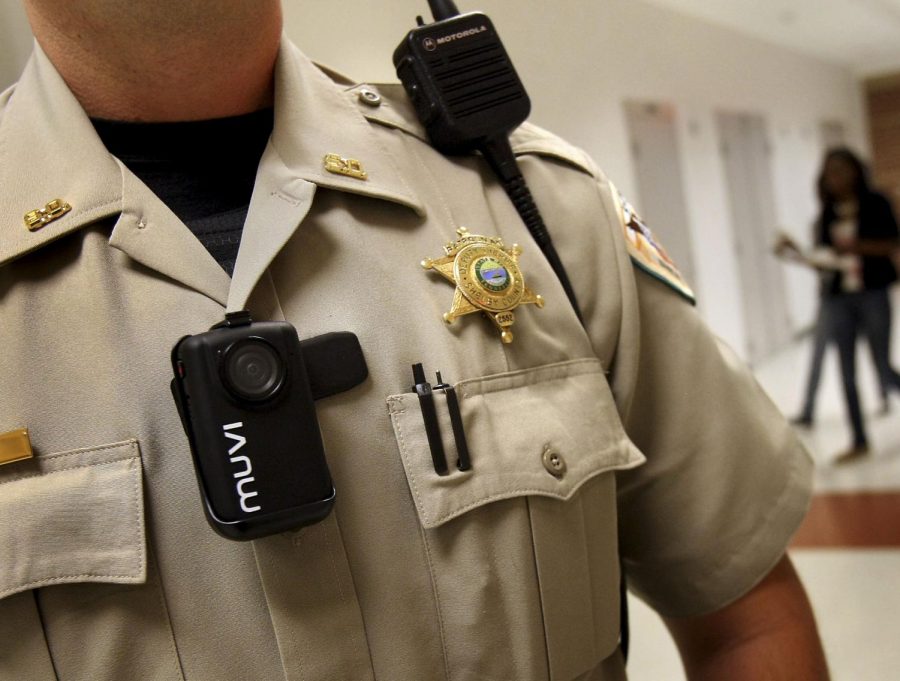Resource officers are not the answer
Opinion columnist Brenna Wolfe says that additional school resource officers are not a viable solution to school shootings.
Mar 26, 2018
In the wake of the Maryland shooting last week, people are turning to school resource officers as the solution to school shootings. This sounds like a good idea in theory.
If there is violence in schools, we should put police officers there to stop it, right? However, school resource officers (SROs) are not adequately trained for interactions with children. What we are seeing in schools is the increase of resource officers in urban areas, excessive force, racial bias and the reinforcement of the school to prison pipeline.
First, let us define what a school resource officer is. They are sworn, certified law enforcement officers but are not required to be trained by or registered with the National Association of School Resource Officers (NASRO). Because this certification and training is not required, unfortunate student-police incidents are happening in our schools.
The Maryland and Parkland shootings are bringing SROs to the front of the national debate about gun violence. Are they the solution?
In the Maryland shooting, the shooter shot two other students before the school resource officer intervened. The officer shot the perpetrator, who was later pronounced dead.
This was a success story; no one is arguing that. But this is rare. A month ago, in the Parkland shooting, the school resource officer did not have active shooter training and remained outside while 17 students and teachers were shot dead. SROs are not always the heroes of the day.
Since Columbine in 1999, there has been a skyrocketing trend of SROs around the country. Before Columbine, there was hardly any police officers in schools.
According to David Tomar, editor of The Quad magazine, in 2007, there were 17,000 officers in schools. Now there are 46,000 full-time and 36,000 part-time officers in schools. Between 2013 and 2014, 42 percent of all public schools in the U.S. were visited or patrolled by SROs. This is a dramatic increase in school policing that has occurred over two decades.
We are now witnessing some of the consequences — namely, increased confrontations with law enforcement and underage students. In 2016 in Collingswood, New Jersey, a nine-year-old was interrogated without their guardian or legal counsel. A typical dispute over sharing brownies in a third-grade classroom now involved a law enforcement officer.
The Prosecutor’s Office handed down instructions for that school to involve police officers for even name-calling incidents. This is over-policing. Typical school disturbances should be dealt with by teachers and principals. Police officers should enforce criminal laws, not school policy.
A similar incident occurred in 2015 in Columbia, South Carolina where a fourteen-year-old boy was interrogated by the police for over an hour without alerting his parents. This is unethical and illegal.
This lack of training is hurting our children. According to Tomar, the majority of SROs indicated that they received fewer than 10 hours of juvenile justice education and training across their entire careers.
This means that SROs are literally trained to treat children as adults: to use force and arrests as the solution. We cannot treat our children as adults.
We are also observing arrests for nonviolent disturbances. In Columbia, South Carolina in 2015, a 16-year-old girl was being disrespectful and using her phone in the classroom. The SRO came in and violently threw her to the ground during the arrest.
This is a matter for school principals; she was nonviolently disturbing a classroom. This is a typical high schooler, and now she was attacked and arrested for violating school policy. She now has a permanent police record for being on her phone in class.
In 2014, the youngest school arrest happened to a four-year-old in Virginia. A child with special needs was acting aggressively toward the principal and director of special education.
The sheriff arrived, placed the child in handcuffs, put him in the back of the police car, put the boy into a jail cell and put leg shackles on him. Instead of the school handling an angry four-year-old with disabilities, the sheriff traumatized the child by locking him up.
This is how the school to prison pipeline is occurring. Children are being arrested for violating school policies.
In the United States, the data shows that black students make up 27 percent of the students referred to law enforcement, even though they make up only 16 percent of the school population (Education World, 2012).
In addition, black students are also making up 31 percent of the school-related arrests. We are literally pushing black students out of schools and into jail for normal, age-appropriate disturbances.
Washington University Law Review found that the odds of a student who has committed a low-level offense being referred to law enforcement are between 1.38 and 1.83 times greater in schools where there is a SRO presence.
Without properly trained school resource officers, we are hurting our students and creating an unsafe environment. SROs are not the answer to gun violence.
More problems are being created with school policing. Instead of increasing the amount of police officers we have in schools, we should properly train the ones that already exist.








